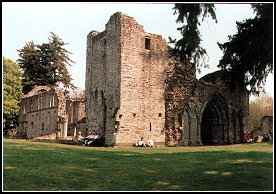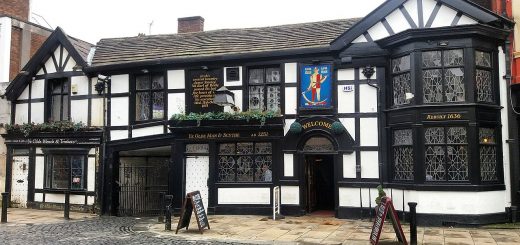The Tulip Staircase, Queens House
On Sunday 19th June 1966 a retired couple from Canada captured an extraordinary image on camera whilst visiting the Queens House in Greenwich. They took what is arguably the best known apparent photograph of a ghost. But this photograph is not the only piece of evidence that suggests The Queens House is haunted.
The Queens House was a late addition to the Palace of Greenwich (Royal Palace of Placentia – Tudor name), it was designed by Inigo Jones and commissioned by Anne of Denmark, wife of King James I (reigned 1603-1625). It is said he gave her Greenwich as an apology for swearing at her in public after she accidentally shot one his dogs whilst hunting in 1614. It was as a building for private retreat and entertainment, but also to straddle the Deptford to Woolwich road that ran between the Palace Gardens and the Royal Park, thus providing a bridge for the Queen and guests enabling them to pass between the two unseen.
Work on the the Queens House started in 1616 but was short lived as the Queen fell ill in 1618 and passed away in 1619. Construction ceased when she became ill, and the building was thatched over at the first floor. It remained so for ten years, then King Charles I decided to recall Inigo Jones (1573-1652)and have it completed for his wife Queen Henrietta Maria (1609-1669). It was completed in 1635 and the design was considered revolutionary. She did not have long to enjoy the building before the the English Civil War started in 1642 which would lead to the execution of her husband King Charles I.
During the Civil War the Palace of Greenwich was allowed to fall into disrepair parts of it were used as a prisoner of war camp, and other parts as a biscuit factory. The Queens House, though losing its treasures, survived the Commonwealth regime and was used as an official government residence. In1657 the house used for the lying-in-state of Admiral Robert Blake.
In 1662 after the Restoration of the Monarchy and the return of Charles II, John Webb was commissioned to enlarge the Queens House for Henrietta Maria, the King’s mother, whilst the Palace of Placentia was demolished and the Greenwich Hospital for Seamen built (now the Old Royal Naval College). Webb added two upper “bridge” rooms. Previously the first floor was designed as an ‘H’ with two blocks rooms joined by a single bridge over the roadway. The two new “bridge” rooms made the upper story into a square as the rooms also bridged the road. It is thought that Henrietta Maria used the house briefly before taking up residence in Somerset House. She died in Paris, France in 1669.
From 1673 space was provided in the House for the Dutchman Willem van de Veldes who was invited by the King to England and founded the English school of marine painting.
The Queens House became the official residence of the Ranger of Greenwich Park in 1690. Lord Romney, Park Ranger, moved the Woolwich road in 1699 to its present position between the Naval Hospital and the Park.
The Queens House was granted to the Naval Asylum School by King George III in 1805. This charity cared for and educated the orphans of seamen. They moved into the building in 1806. During 1807-1812 a series of colonades and wings were added by architect Daniel Asher to meet the needs of the charity. In 1821 it changed it’s name to the Royal Hospital School. The school moved to Holbrook, Suffolk in 1933 and in 1937 The Queens House was opened as the National Maritime Museum.
In the 1980s the House was closed for six years for restoration. It re-opened in 1990. It now represents the style of the House circa 1660.
 The Story Behind the Picture
The Story Behind the Picture
On Sunday 19th June 1966, the Rev R W Hardy and his wife visited the Queens House whilst on holiday from British Columbia, Canada. Around 5.00pm Rev Hardy was taking photographs of the interior of the building and after they were developed he discovered a strange hooded figure on his photograph of the Tulip Staircase. At the time the photograph was taken (between 5.15pm and 5.30pm) his wife was standing with him and confirmed there was nothing on the stair. The staircase itself was closed with a rope and ‘No Admittance’ sign. The Tulip staircase is thought to be the first unsupported spiral stair in Britain and dates back the earliest period of the house. The stairs are supported by a combination of support by cantilever from the walls and each stair resting on the one below.
The photograph negatives have been examined by experts at Kodak and they found no evidence of tampering or manipulation. Rev Hardy had taken the picture on a Zeiss Ikon Contina camera with a Zavar Anastigmat lens and skylight haze filter. He was using K2 daylight film. The camera was handheld, resting on a ledge and the exposure was estimated to be just over a second.
In 1967 the Hardy’s returned to the Queens House and attempted to recreate the photograph with the help of Mr Brian Tremain (museums photographer). The photograph had also sparked the interest of the Ghost Club who on 24th June 1967 held a séance near the location of the Tulip Staircase but it produced little evidence of note.
Strange shadowy figures and unexplainable footsteps have been experienced in the vicinity of the Tulip Staircase by both staff and visitors. It is also suggested that a pale woman has been seen wiping blood from the bottom of the staircase which was supposedly from a maid who came over the highest banister and died at the foot of the stairs 300 years ago. It has also been said that the disembodied chanting of children can be heard within the Queens House.
Monday 20th May 2002 (9.45am):
“Myself and two colleagues were talking about which breaks we were on, when something caught my eye. One of the doors (double) from the Bridge Room closed then he saw a woman and I thought at first it was the girl who does the talks at weekends, then realised the woman just glided across the balcony and went through the wall west side.I could not believe what I saw. I went very cold and the hairs on my arms and neck were on end. We went into the Queen’s Presence Room and looked down toward the old Queen’s Bedroom, and something passed through the ante-room and out through the wall. My two colleagues did also feel cold at that time.The lady was dressed in a white-grey colour, old fashioned, something like a crinoline type dress.” – Tony Anderson, Gallery Assistant, Queens House.




Re: The Tulip Staircase, Queens House
It’s all rather curious stuff. Neither my wife, nor I, would be able to comment validly on location-specific haunting, as we, ourselves, appear to be haunted. I can say that, whilst the haunting is of us, symbolic locations do cause massive peaks in the event levels.
Re: The Tulip Staircase, Queens House
My personal investigations involved bizarre events that had parallels in other cases. In other words, these events had interconnecting operational styles. I detect a sense of humour in their application, too. In this case, however, the only humorous link that I can see may be entirely coincidental. Nonetheless, that conceptual link is between the name ‘Hardy’ (meaning ‘courageous; strong’), the A206 Nelson Road, and the A206 Trafalgar Road outside.
As I have said, this Nelson/Trafalgar connection may be a pure coincidence. And, although Captain Thomas Hardy was genuinely involved, the historical authenticity of the “kiss me Hardy” statement has been challenged. Nonetheless, the alternative “kismet, Hardy” statement is also said to be anachronistic. I have found a reference stating that the term ‘kismet’ was not in use in the English language at the time of Nelson’s death.